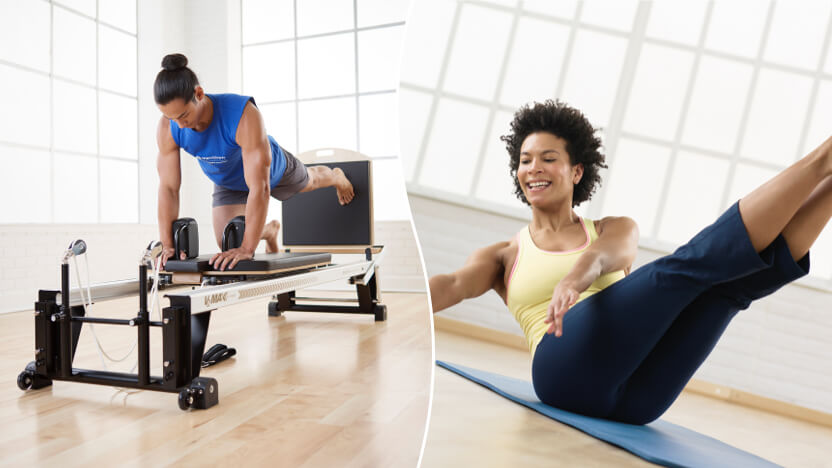
Choosing between Matwork Pilates vs. Reformer Pilates is the classic dilemma for anyone who has ever practiced Pilates. There is a lot of discussion around this topic so we asked Merrithew® Master Instructor Trainer Jennifer Dahl to share her thoughts on the topic and discuss the merits of both mat and Reformer Pilates.
“I am often asked by prospective clients and students which type of Pilates training is best. The truth is, there is a lot to consider to determine which style of workout is best for you as all of us are built differently and have different needs and goals,” says Jennifer.
She explains that there are three aspects that play an important role in determining the right kind of training for you— practicality, fitness level, and balanced programming.
Practicality
“First off, one has to think not about which type of training is more effective overall but what type of training is most effective and appropriate for them at any given time,” explains Jennifer.
“Our bodies and workout routines will change depending on what type of stimulus we are working with. Matwork offers an opportunity to use bodyweight and gravity to navigate through a series of movements and exercises meant to engage and enliven the neuro-myofascial system.
“For Mat Pilates, all you need is enough space for a mat and you can also add a small prop like a Toning Ball™ or a Mini Stability Ball™."
Fitness level
“Matwork is also the building block and foundation that opens the door to a lot of other STOTT PILATES® repertoire. It requires endurance, strength and dynamic alignment, says Jennifer.
“The Reformer repertoire offers an opportunity to expand on the benefits of Matwork Pilates by incorporating external load and resistance. It’s also a great place to explore the concept of feedback and support. This is especially helpful if a client needs more external cues to achieve the correct engagement patterns.
“If your client wants to focus on peripheral loading as their programming goal then the Reformer is a great way to introduce and also expand on that. The carriage movement can often elicit a calming, rhythmic effect that can aid in a better mind-body connection yet also provide a moving stimulus that can fine-tune our responsiveness and improve balance.”
Balanced programming
The most effective programming combines elements of both Matwork and Reformer Pilates exercises.
“Sometimes that ratio needs to be tweaked according to what different clients need. I personally gravitate to the STOTT PILATES Essential Matwork repertoire when I need to connect and assess where I’m at. If all seems good to go then I push myself with an Intermediate/Advanced sequence that ensures that my whole body is activated and connected overall,” says Jennifer.
“I love the freedom the space on the mat offers. On the other hand, when I need more guidance and am struggling with engagement or activation patterns, I'll often turn to the STOTT PILATES Essential Reformer-based repertoire.”
In the end, both Matwork and Reformer Pilates offer many benefits and are great when you adhere to and respect their variability, progressiveness and appropriate programming disciplines. The best approach would be to switch between the two and find out what works best for you.
Check out the upcoming workshops by Jennifer Dahl.